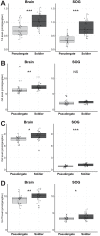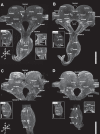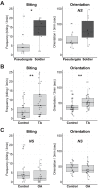Tyraminergic and Octopaminergic Modulation of Defensive Behavior in Termite Soldier
- PMID: 27196303
- PMCID: PMC4873212
- DOI: 10.1371/journal.pone.0154230
Tyraminergic and Octopaminergic Modulation of Defensive Behavior in Termite Soldier
Abstract
In termites, i.e. a major group of eusocial insects, the soldier caste exhibits specific morphological characteristics and extremely high aggression against predators. Although the genomic background is identical to the other non-aggressive castes, they acquire the soldier-specific behavioral character during the course of caste differentiation. The high aggressiveness and defensive behavior is essential for colony survival, but the neurophysiological bases are completely unknown. In the present study, using the damp-wood termite Hodotermopsis sjostedti, we focused on two biogenic amines, octopamine (OA) and tyramine (TA), as candidate neuromodulators for the defensive behavior in soldiers. High-performance liquid chromatographic analysis revealed that TA levels in the brain and suboesophageal ganglion (SOG) and the OA level in brain were increased in soldiers than in pseudergates (worker caste). Immunohistochemical analysis revealed that TA/OA neurons that innervate specific areas, including the mandibular muscles, antennal nerve, central complex, suboesophageal ganglion, and thoracic and/or abdominal ganglia, were enlarged in a soldier-specific manner. Together with the results that pharmacological application of TA promoted the defensive behavior in pseudergates, these findings suggest that the increased TA/OA levels induce the higher aggressiveness and defensive behavior in termite soldiers. The projection targets of these soldier-specific enlarged TA/OA neurons may have important roles in the higher aggressiveness and defensive behavior of the termite soldiers, inducing the neuronal transition that accompanies external morphological changes.
Conflict of interest statement
Figures





Similar articles
-
Gene expression changes during caste-specific neuronal development in the damp-wood termite Hodotermopsis sjostedti.BMC Genomics. 2010 May 20;11:314. doi: 10.1186/1471-2164-11-314. BMC Genomics. 2010. PMID: 20482890 Free PMC article.
-
Soldier-specific modification of the mandibular motor neurons in termites.PLoS One. 2008 Jul 9;3(7):e2617. doi: 10.1371/journal.pone.0002617. PLoS One. 2008. PMID: 18612458 Free PMC article.
-
Soldier morphogenesis in the damp-wood termite is regulated by the insulin signaling pathway.J Exp Zool B Mol Dev Evol. 2013 Jul;320(5):295-306. doi: 10.1002/jez.b.22501. Epub 2013 May 23. J Exp Zool B Mol Dev Evol. 2013. PMID: 23703784
-
The making of the defensive caste: Physiology, development, and evolution of the soldier differentiation in termites.Evol Dev. 2020 Nov;22(6):425-437. doi: 10.1111/ede.12335. Epub 2020 Apr 14. Evol Dev. 2020. PMID: 32291940 Review.
-
The soldiers in societies: defense, regulation, and evolution.Int J Biol Sci. 2014 Mar 5;10(3):296-308. doi: 10.7150/ijbs.6847. eCollection 2014. Int J Biol Sci. 2014. PMID: 24644427 Free PMC article. Review.
Cited by
-
The Biogenic Amine Tyramine and its Receptor (AmTyr1) in Olfactory Neuropils in the Honey Bee (Apis mellifera) Brain.Front Syst Neurosci. 2017 Oct 24;11:77. doi: 10.3389/fnsys.2017.00077. eCollection 2017. Front Syst Neurosci. 2017. PMID: 29114209 Free PMC article.
-
Differentiation of workers into soldiers is associated with a size reduction of higher-order brain centers in the neotropical termite Procornitermes araujoi.Sci Rep. 2023 Oct 25;13(1):18279. doi: 10.1038/s41598-023-45221-0. Sci Rep. 2023. PMID: 37880273 Free PMC article.
-
Comparative Antennal Morphometry and Sensilla Organization in the Reproductive and Non-Reproductive Castes of the Formosan Subterranean Termite.Insects. 2021 Jun 24;12(7):576. doi: 10.3390/insects12070576. Insects. 2021. PMID: 34202744 Free PMC article.
-
Cooperative defence operates by social modulation of biogenic amine levels in the honey bee brain.Proc Biol Sci. 2018 Jan 31;285(1871):20172653. doi: 10.1098/rspb.2017.2653. Proc Biol Sci. 2018. PMID: 29367399 Free PMC article.
-
Downregulation of Orco and 5-HTT Alters Nestmate Discrimination in the Subterranean Termite Odontotermes formosanus (Shiraki).Front Physiol. 2019 Jun 11;10:714. doi: 10.3389/fphys.2019.00714. eCollection 2019. Front Physiol. 2019. PMID: 31244679 Free PMC article.
References
-
- Hermann HR. Defensive Mechanisms In Social Insects. New York: Praeger Publishers; 1984. 259p.
-
- Wilson EO. The Insect Societies. Cambridge, Massachusetts: The Belknap Press of Harvard University Press; 1971. 548 p.
-
- Aoki S. Colophina clematis (Homoptera, Pemphigidae), and aphid species with "soldiers". Kontyû. 1977;45(2):276–82.
-
- Duffy JE. Eusociality in a coral-reef shrimp. Nature. 1996;381(6582):512–4. 10.1038/381512a0 WOS:A1996UP43500056. - DOI
Publication types
MeSH terms
Substances
LinkOut - more resources
Full Text Sources
Other Literature Sources

